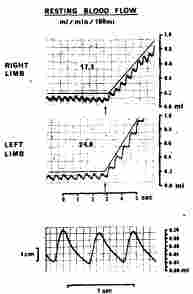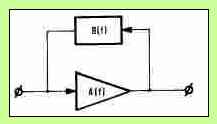PLETHYSMOGRAPHY
What is venous occlusion plethysmography? It is a method to study the arterial blood flow into a limb or an organ through closing the venous outflow. The limb will then swell. The rate of increase of the volume of the limb is a measure of the arterial inflow. There are various methods to do that.

One method is immersing the limb in a chamber filled with water and then measure the water displacement.
Another is to measure the growth in circumference of the limb by means of a mercury strain-gauge, assuming that that growth is more or less proportional to the volume increase, or that it at least qualitatively reflects it.
A third method is capacitive plethysmography. Here, the limb is enclosed in a non-touching metal sleeve and the electric capacitance between the sleeve and the limb surface is measured.
ARTICLES:
“Venous
occlusion plethysmography”,
a review of various plethysmographic methods published in Biomedical
Engineering,
Vol. 10, No. 8 and No. 9, 1975
This
is an electronic version of an article published in Biomedical Engineering, now
called Journal of Medical Engineering & Technology©,
Copyright Taylor & Francis; Journal of Medical Engineering and Technology is
available online at
http://www.informaworld.com. It is here made available with permission of the publisher.
“Technik
und Verfahren der Venenverschlußplethysmographie”,
a similar review in German published in Acta
Medicotechnika, Vol. 19, No. 10 and No. 11, 1971
published by Helios-Verlag GmbH in Berlin. Here made available with the permission of Richard Pflaum Verlag,
Munich (Germany), which later acquired the rights and for some time continued
the publishing of the journal.
“A Critical Review of the Theory of the Mercury Strain-Gauge Plethysmograph”, Medical & Biological Engineering, Vol 7, 1969
“A
Theoretical Study of Capacitive Plethysmography”,
Medical &
Biological Engineering,
Vol 9, 1971
The two latter articles are here made availably with the
permission of the International Federation of Medical and Biological
Engineering, IFMBE.
ELECTRONIC
INSTRUMENTATION
In connection with plethysmography (and many other things in medical engineering...), electronic amplifiers will be needed. The following article gives an overview, intended to give persons who are not electronic engineers – especially in the medical profession – an idea of the properties of such amplifiers:
“Properties and Limitations of Electronic Instrumentation”, Chapter 74 in
Medical
Engineering,
ed. by Charles D. Ray, Year Book Medical Publishers, Chicago, 1974
The publisher no more exists.
I received a personal permission by Dr. Charles D. Ray to
include a PDF file of my publication on this webpage. After much search, I
finally found out that the rights of Year Book Publisher were acquired by
Elsevier. For some completely inunderstandable reason Elsevier refused, however,
to give me their permission, without stating a reason (even though the book will
beyond doubt never be published again, since most of its content is now
outdated) –
the
only publisher who refused permission...
Yet
I make use of the legal right of the author to send reprints to anyone who requests
it. I even received a number of printed reprints from the publisher (as is common practice in
case of a scientific publication). In
such a case the author has the right to send a copy to anyone who asks for it.
So if anyone requests a copy by e-mail (or ordinary mail), I will send it in a
letter or easier in the form of a PDF file
as an attachment to my reply.
Too make it easier for you, I have here, as a “workaround”, added an automatic request for a reprint of this now 40 years old but still relevant article (by many still considered to be an excellent review). It works as follows:
“I herewith request a personal reprint of the article Properties and Limitations of Electronic Instrumentation for my private use. By clicking HERE, I confirm this request and will receive my personal reprint directly.” (You get the reprint immediately as a PDF and no personal data will be recorded.)